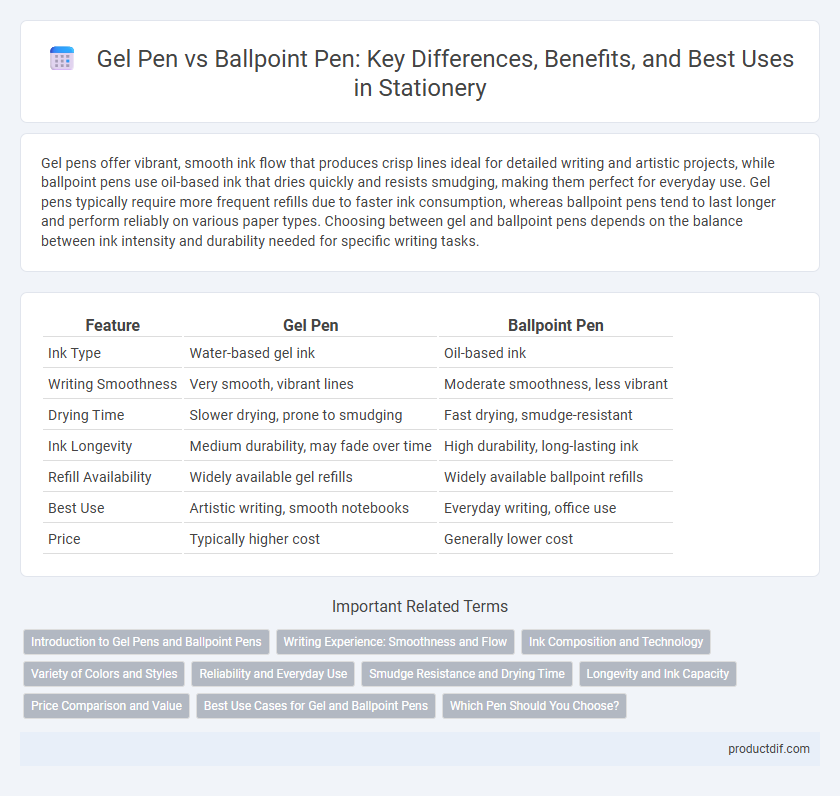Gel pens offer vibrant, smooth ink flow that produces crisp lines ideal for detailed writing and artistic projects, while ballpoint pens use oil-based ink that dries quickly and resists smudging, making them perfect for everyday use. Gel pens typically require more frequent refills due to faster ink consumption, whereas ballpoint pens tend to last longer and perform reliably on various paper types. Choosing between gel and ballpoint pens depends on the balance between ink intensity and durability needed for specific writing tasks.
Table of Comparison
| Feature | Gel Pen | Ballpoint Pen |
|---|---|---|
| Ink Type | Water-based gel ink | Oil-based ink |
| Writing Smoothness | Very smooth, vibrant lines | Moderate smoothness, less vibrant |
| Drying Time | Slower drying, prone to smudging | Fast drying, smudge-resistant |
| Ink Longevity | Medium durability, may fade over time | High durability, long-lasting ink |
| Refill Availability | Widely available gel refills | Widely available ballpoint refills |
| Best Use | Artistic writing, smooth notebooks | Everyday writing, office use |
| Price | Typically higher cost | Generally lower cost |
Introduction to Gel Pens and Ballpoint Pens
Gel pens use water-based pigment ink that offers vibrant colors and smooth application, making them ideal for detailed writing and artistic projects. Ballpoint pens contain oil-based ink that dries quickly and resists smudging, providing reliable performance for everyday writing tasks. Both pen types vary in ink consistency, flow rate, and finish, impacting user preference and writing experience.
Writing Experience: Smoothness and Flow
Gel pens offer a smoother writing experience due to their water-based ink, which flows more consistently and produces vibrant, bold lines on paper. Ballpoint pens use oil-based ink, resulting in a drier, more controlled flow that can feel less smooth but reduces smudging and ink bleeding. Users seeking effortless, fluid strokes often prefer gel pens, while those prioritizing longevity and precision may choose ballpoint pens.
Ink Composition and Technology
Gel pens utilize water-based gel ink composed of pigment suspended in a water-soluble carrier, offering vivid colors and smooth flow due to its thicker consistency and advanced water-dispersible polymers. Ballpoint pens use oil-based ink, which is thicker and dries quickly, relying on a controlled ink release mechanism involving a rotating ball bearing to reduce smudging and ensure durability. The technological distinction lies in gel pens' ability to deliver more opaque, vibrant lines, while ballpoint pens excel in longevity and less maintenance due to their fast-drying, oil-based ink formulation.
Variety of Colors and Styles
Gel pens offer a broader variety of vibrant colors and stylish designs compared to ballpoint pens, making them popular for artistic and creative uses. Ballpoint pens typically come in standard colors like blue, black, and red with more traditional, utilitarian styles suitable for everyday writing. The extensive color range and sleek options of gel pens enhance personalization and visual appeal in stationery collections.
Reliability and Everyday Use
Gel pens offer smoother ink flow and more vibrant colors, making them ideal for detailed writing and artistic tasks, while ballpoint pens provide consistent reliability with less smudging, suited for long-lasting everyday use. The oil-based ink in ballpoint pens dries quickly and resists water, ensuring durability on various surfaces, whereas gel pens may require more careful handling to prevent smears. For daily writing needs, ballpoint pens are favored due to their lower maintenance and extended ink lifespan, while gel pens excel in precision and vividness.
Smudge Resistance and Drying Time
Gel pens offer vibrant ink but tend to have slower drying times, increasing the risk of smudging, especially on glossy or coated paper. Ballpoint pens use oil-based ink that dries quickly, providing superior smudge resistance and making them ideal for fast note-taking or left-handed writers. Choosing between gel and ballpoint pens depends on balancing the need for vivid color against the importance of quick ink drying and clean writing.
Longevity and Ink Capacity
Gel pens typically offer vibrant ink with smoother writing but have a shorter lifespan due to faster ink consumption compared to ballpoint pens. Ballpoint pens use oil-based ink that dries quickly and lasts longer, providing greater ink capacity and extended writing time. For those prioritizing longevity and ink volume, ballpoint pens generally outperform gel pens in durability and endurance.
Price Comparison and Value
Gel pens typically cost more than ballpoint pens due to their smooth ink flow and vibrant colors, offering enhanced writing quality for a slightly higher investment. Ballpoint pens are more affordable and have a longer ink lifespan, providing greater value for everyday writing tasks. When considering price versus performance, gel pens offer superior precision and comfort, while ballpoint pens excel in cost-efficiency and durability.
Best Use Cases for Gel and Ballpoint Pens
Gel pens excel in vibrant, smooth writing on glossy paper and artwork requiring rich colors, making them ideal for journaling, drawing, and detailed note-taking. Ballpoint pens offer durability and quick drying ink suitable for everyday writing tasks, forms, and documents needing smear-proof text. Schoolwork, office use, and long writing sessions benefit from ballpoint pens' reliability and gel pens' vivid ink intensity for creative projects.
Which Pen Should You Choose?
Gel pens offer vibrant, smooth ink flow ideal for detailed writing and artistic projects, while ballpoint pens provide durability and longer-lasting ink suited for everyday use and quick note-taking. Gel ink, often water-based, dries slower but produces richer colors, whereas ballpoint ink is oil-based, resulting in faster drying times and reduced smudging. Choosing between gel and ballpoint pens depends on your need for precision and color intensity versus practicality and longevity.
Gel pen vs Ballpoint pen Infographic

 productdif.com
productdif.com